
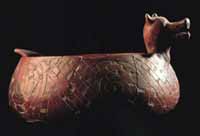 |
Underwater monster bowl, Houston-Shryock site, Fulton County. | |
|
This bowl may symbolize the underwater monster, a creature thought to be a part of Native American beliefs for at least the last two thousand years. Tribes in the southeastern part of the United States fear and admire this creature, which is associated with lightning, thunder, rain, water, and with power over plants and animals. |
||
Based on some of the designs placed on pottery and engraved into marine shell, archaeologists believe Mississippian people divided their world into three parts: the upper world, the middle world and the underworld. The upper world includes the sun, that which gives life. The middle world is the world we live in on earth. The lower world is the source of fertility, among other things.
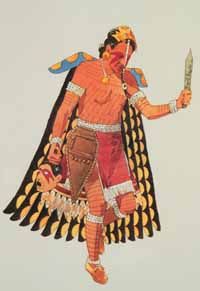 |
Artist's illustration of a falcon dancer. | |
|
Mississippian rituals often appear to depict the power of nature. In this illustration, a dancer is transformed by a feathered cape and mask into a falcon. In his left hand he holds a large stone knife or dance sword. Also note the shell beads around his arms, legs, and waist, and the forked eye symbol. |
||
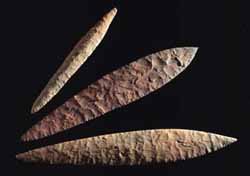 |
Ramey knives or 'dance swords,' Brown and Schuyler counties. | |
|
Some engraved marine shells show dancers holding long Ramey-like knives, suggesting that these tools may have been used for ritual purposes. |
||
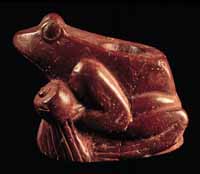 |
'Rattler' frog pipe, St. Clair County. | |
|
Some archaeologists have interpreted this figurine as a shaman or medicine man transformed into a frog to travel to the underworld. The rattle in the right forefoot was used to induce a trance through a rhythmic beat. This pipe is made of flint clay, a microcrystalline clay rock, the same material used to make the Birger figurine. |
||
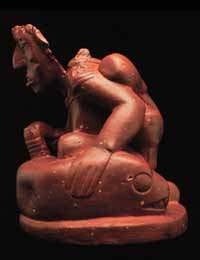
|
Birger figurine, BBB Motor site, Madison County. Photograph by Michael Brohm; original artifact at the Illinois Transportation Archaeological Resarch Program, University of Illinois at Urbana-Champaign
In the first image, we see a woman cultivating the back of the serpent. In the second image, the tail of the serpent is spilt into two parts. In the third image, the two parts of the serpent's tail are transformed into gourd-bearing vines. |
|
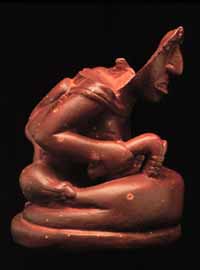 |
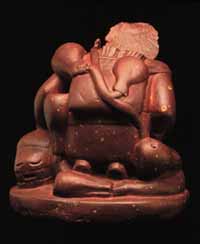 |
|
Mississippian statues provide a glimpse into their beliefs. For example, the Birger figurine, which was found on the edge of the Cahokia site in Madison County, depicts a woman kneeling on the back of a serpent that has a mouth filled with animal teeth. She wields a hoe in her right hand and appears to be cultivating the back of the serpent. The serpent's tail is growing up the back of the woman, where it turns into a vine filled with gourds or squash. Based on traditional and contemporary Native American beliefs, the serpent may be a spiritual being called the underwater monster, which is a symbol of fertility.
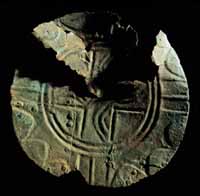 |
Copper gorget, Dickson Mounds site, Fulton County. | |
|
There are many symbols embossed into this copper gorget. In the center of the piece we see another version of the circle and cross. Judging from the scalloped lines around the edge of the gorget, the sun is also part of the symbolism illustrated here. Note the pie-shaped piece of copper in the lower left hand corner that has been attached with small rivets. |
||
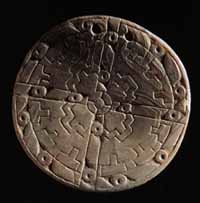 |
Shell gorget, Crable site, Fulton County. |
The Mississippian world was also illustrated in copper and shell. This shell gorget appears to have 'clouds' around its edge.
This marine shell image is often associated with the afterlife.
|
|
Copyright © 2000 Illinois State Museum